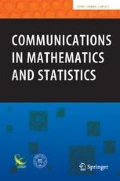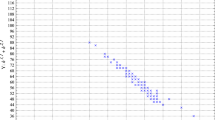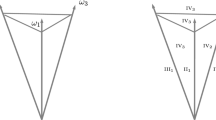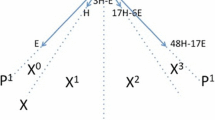Abstract
We give a differential-geometric construction of Calabi–Yau fourfolds by the ‘doubling’ method, which was introduced in Doi and Yotsutani (N Y J Math 20:1203–1235, 2014) to construct Calabi–Yau threefolds. We also give examples of Calabi–Yau fourfolds from toric Fano fourfolds. Ingredients in our construction are admissible pairs, which were first dealt with by Kovalev (J Reine Angew Math 565:125–160, 2003). Here in this paper an admissible pair \((\overline{X},D)\) consists of a compact Kähler manifold \(\overline{X}\) and a smooth anticanonical divisor D on \(\overline{X}\). If two admissible pairs \((\overline{X}_1,D_1)\) and \((\overline{X}_2,D_2)\) with \(\dim _{\mathbb {C}}\overline{X}_i=4\) satisfy the gluing condition, we can glue \(\overline{X}_1\setminus D_1\) and \(\overline{X}_2\setminus D_2\) together to obtain a compact Riemannian 8-manifold (M, g) whose holonomy group \(\mathrm {Hol}(g)\) is contained in \(\mathrm {Spin}(7)\). Furthermore, if the \(\widehat{A}\)-genus of M equals 2, then M is a Calabi–Yau fourfold, i.e., a compact Ricci-flat Kähler fourfold with holonomy \(\mathrm {SU}(4)\). In particular, if \((\overline{X}_1,D_1)\) and \((\overline{X}_2,D_2)\) are identical to an admissible pair \((\overline{X},D)\), then the gluing condition holds automatically, so that we obtain a compact Riemannian 8-manifold M with holonomy contained in \(\mathrm {Spin}(7)\). Moreover, we show that if the admissible pair is obtained from any of the toric Fano fourfolds, then the resulting manifold M is a Calabi–Yau fourfold by computing \(\widehat{A}(M)=2\).
Similar content being viewed by others
Notes
In the practical computation we used packages (a) Macaulay2 and (b) Maxima. These open source algebra systems are available at http://www.math.uiuc.edu/Macaulay2 and http://maxima.sourceforge.net respectively.
References
Batyrev, V.V.: On the classification of toric Fano \(4\)-folds. Algebraic geometry, \(9\). J. Math. Sci. (New York) 94, 1021–1050 (1999)
Cox, D.: The homogeneous coordinate ring of a toric variety. J. Algebr. Geom 4, 15–50 (1995)
Cox, D., Little, J., Schenck, H.: Toric Varieties (Graduate Studies in Mathematics), vol. 124. AMS, Providence (2011)
Doi, M.: Gluing construction of compact complex surface with trivial canonical bundle. J. Math. Soc. Jpn. 61, 853–884 (2009)
Doi, M., Yotsutani, N.: Doubling construction of Calabi–Yau threefolds. N. Y. J. Math. 20, 1203–1235 (2014)
Dolgachev, I.: Lectures on Invariant Theory. Cambridge University Press, Cambridge (2003)
Fulton, W.: Introduction to Toric Varieties, Annals of Mathematics Studies 131. Princeton University Press, Princeton (1993)
Graded Ring Database. http://grdb.lboro.ac.uk/forms/toricsmooth
Harvey, R.: Spinors and Calibrations, Perspectives in Mathematics 9. Academic Press, San Diego (1990)
Hein, H.-J.: Complete Calabi–Yau metrics from \({\mathbb{P}}^2\) #9 \(\overline{\mathbb{P}}^2\).arXiv:1003.2646
Joyce, D.D.: Compact Manifolds with Special Holonomy, Oxford Mathematical Monographs. Oxford University Press, Oxford (2000)
Kovalev, A.: Twisted connected sums and special Riemannian holonomy. J. Reine Angew. Math. 565, 125–160 (2003)
Salamon, S.M.: Riemannian Geometry and Holonomy Groups, Pitman Research Notes in Mathematics 201. Longman, Harlow (1989)
Sato, H.: Studies on Toric Fano Varieties, pp 1–99. Tohoku Mathematical Publications 23. Tohoku University, Math Institute, Sendai (2002)
Tian, G., Yau, S.-T.: Complete Kähler manifolds with zero Ricci curvature. I. J. Am. Math. Soc. 3, 579–609 (1990)
Acknowledgments
The second author would like to thank Dr. Craig van Coevering and Dr. Jinxing Xu for their valuable comments when he was in University of Science and Technology of China.
Author information
Authors and Affiliations
Corresponding author
Rights and permissions
About this article
Cite this article
Doi, M., Yotsutani, N. Doubling Construction of Calabi–Yau Fourfolds from Toric Fano Fourfolds. Commun. Math. Stat. 3, 423–447 (2015). https://doi.org/10.1007/s40304-015-0066-x
Received:
Accepted:
Published:
Issue Date:
DOI: https://doi.org/10.1007/s40304-015-0066-x




